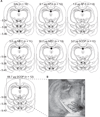Distinct effects of ventral tegmental area NMDA and acetylcholine receptor blockade on conditioned reinforcement produced by food-associated cues
- PMID: 26093048
- PMCID: PMC4510872
- DOI: 10.1016/j.neuroscience.2015.06.021
Distinct effects of ventral tegmental area NMDA and acetylcholine receptor blockade on conditioned reinforcement produced by food-associated cues
Abstract
Stimuli paired with rewards acquire reinforcing properties to promote reward-seeking behavior. Previous work supports the role of ventral tegmental area (VTA) nicotinic acetylcholine receptors (nAChRs) in mediating conditioned reinforcement elicited by drug-associated cues. However, it is not known whether these cholinergic mechanisms are specific to drug-associated cues or whether VTA cholinergic mechanisms also underlie the ability of cues paired with natural rewards to act as conditioned reinforcers. Burst firing of VTA dopamine (DA) neurons and the subsequent phasic DA release in the nucleus accumbens (NAc) plays an important role in cue-mediated behavior and in the ability of cues to acquire reinforcing properties. In the VTA, both AChRs and N-methyl-d-aspartate receptors (NMDARs) regulate DA burst firing and phasic DA release. Here, we tested the role of VTA nAChRs, muscarinic AChRs (mAChRs), and NMDARs in the conditioned reinforcement elicited by a food-associated, natural reward cue. Subjects received 10 consecutive days of Pavlovian conditioning training where lever extension served as a predictive cue for food availability. On day 11, rats received bilateral VTA infusion of saline, AP-5 (0.1 or 1μg), mecamylamine (MEC: 3 or 30μg) or scopolamine (SCOP: 3 or 66.7μg) immediately prior to the conditioned reinforcement test. During the test, nosepoking into the active (conditioned reinforced, CR) noseport produced a lever cue while nosepoking on the inactive (non-conditioned reinforced, NCR) noseport had no consequence. AP-5 robustly attenuated conditioned reinforcement and blocked discrimination between CR and NCR noseports at the 1-μg dose. MEC infusion decreased responding for both CR and NCR while 66.7-μg SCOP disrupted the subject's ability to discriminate between CR and NCR. Together, our data suggest that VTA NMDARs and mAChRs, but not nAChRs, play a role in the ability of natural reward-associated cues to act as conditioned reinforcers.
Keywords: NMDA receptor; conditioned reinforcement; incentive salience; muscarinic receptor; nicotinic receptor; ventral tegmental area.
Copyright © 2015 IBRO. Published by Elsevier Ltd. All rights reserved.
Figures






References
-
- Ball KT, Combs TA, Beyer DN. Opposing roles for dopamine D1- and D2-like receptors in discrete cue-induced reinstatement of food seeking. Behav Brain Res. 2011;222:390–393. - PubMed
-
- Brunzell DH, Chang JR, Schneider B, Olausson P, Taylor JR, Picciotto MR. beta2-Subunit-containing nicotinic acetylcholine receptors are involved in nicotine-induced increases in conditioned reinforcement but not progressive ratio responding for food in C57BL/6 mice. Psychopharmacology (Berl) 2006;184:328–338. - PubMed
Publication types
MeSH terms
Substances
Grants and funding
LinkOut - more resources
Full Text Sources
Other Literature Sources

